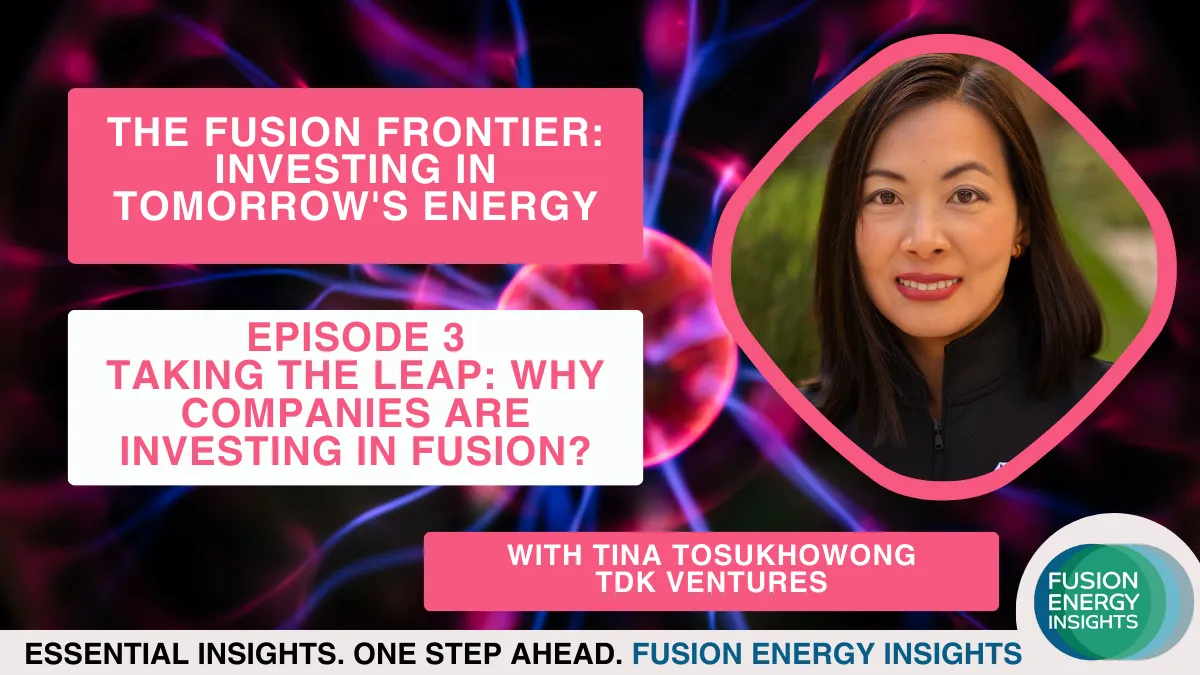Taking the Leap: Why Companies are Investing in Fusion with Tina Tosukhowong
In our recent podcast series, The Fusion Frontier: Investing in Tomorrow’s Energy, we spoke to experts in fusion energy and investment to dig deeper into the potential of fusion as a clean energy source, why investors invest in fusion, and some of the risks and opportunities along the way.
In Episode 3, we spoke to Tina Tosukhowong, Investment Director at TDK Ventures, to understand why fusion is an attractive investment option for forward-thinking investors.

Here are 3 key insights from the conversation.
1. Fusion has the capacity to generate huge amounts of revenue and return on investment just within energy production
Return on an investment is based on many factors, including the potential revenue generation of a company and the size of the market.
For fusion investment, the returns are potentially enormous as fusion is about a new energy paradigm – the global energy market is vast and if we consider fusion energy as just replacing coal-fired power stations then even that is “a tens of trillion dollars market” notes Tina.
The energy production market globally is looking to transition to non-fossil fuel technologies such as fusion. Solar power production has already demonstrated, since 2010, that with investment the technology can mature and costs can fall.
Looking at the coming 5-10 years, Tina says we could see something similar with fusion. Over the next decade we will see the realisation of many fusion technology demonstration facilities coming to market, which will be supported by a mixture of private investment and government funding, and this will help to prove the technology and help costs of production decrease.
2. When investing in fusion, consider the technology but also the company
Tina argues the importance of weighing up which fusion companies to invest in.
First, consider the company’s technical goals and ability. Second, consider the team that the company has trying to achieve the organisational goals – “do they have the ability to manage the company and to scale it?” asks Tina.
The 2023 Fusion Industry Association report calculated that there's been over $6 billion of investment in the fusion market and Tina notes that a market of that size means a variety of investors: “You've seen sovereign funds, you've seen institutional growth, private equity, retirement funds that have invested in the likes of Commonwealth Fusion Systems and other companies”.
Fusion is no longer a niche investment but has a variety of funding sources.

Fusion energy investment has “100% alignment,” to ESG investment goals
3. Investment in fusion energy is one the most important and relevant strategies to achieving an investor's ESG goals
ESG is Environmental, Social, Governance – together they form three pillars that investors want their investment portfolios to consider.
Fusion energy investment has “100% alignment,” according to Tina, to ESG investment goals because fusion energy is sustainable energy, non-fossil fuel based in a world suffering from the effects of climate change.
Although we have emerging technologies of carbon capture and storage which would allow the continuation of burning fossil fuels, Tina notes that these are expensive and require large energy consumption to fuel the capture technology, and there is a waste problem with the captured carbon.
Alternately, fusion energy offers a new energy production technology not based on fossil fuels and with a small waste burden. Although, like everything, fusion still carries risks, Tina argues that it is “the option that humanity has to take.”
And finally…
Tina says “I think the time to start investing in fusion is now because this is the industry that, if it is successful, is going to change the course of energy generation in the coming decades. You cannot deny that this is the technology that can provide energy 24/7 and the footprint is small. A cup of fusion fuel is equivalent to a 500 megawatt coal power plant and you don't need to get fossil fuels out of the ground. This is one of the silver bullets that we should have in the toolbox. So, I would encourage people who haven't invested in fusion to seriously look at it.”
